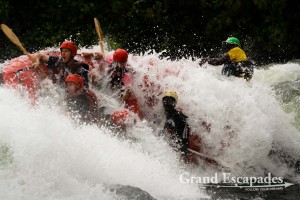 There are six levels each referred to as “Grade” or “Class” followed by a number. The scale is not linear, nor is it fixed. For instance, there can be hard grade twos, easy grade threes, and so on. The grade of a river may change with the level of flow. Often a river or rapid will be given a numerical grade, and then a plus (+) or minus (-) to indicate if it is in the higher or lower end of the difficulty level. Also note that while a river section may be given an overall grading, it may contain sections above or lower that grade.
There are six levels each referred to as “Grade” or “Class” followed by a number. The scale is not linear, nor is it fixed. For instance, there can be hard grade twos, easy grade threes, and so on. The grade of a river may change with the level of flow. Often a river or rapid will be given a numerical grade, and then a plus (+) or minus (-) to indicate if it is in the higher or lower end of the difficulty level. Also note that while a river section may be given an overall grading, it may contain sections above or lower that grade.
Class I: Easy – Waves small; passages clear; no serious obstacles.
Class II: Medium – Rapids of moderate difficulty with passages clear. Requires experience plus suitable outfit and boat
Class III: Difficult – Waves numerous, high, irregular; rocks; eddies; rapids with passages clear though narrow, requiring expertise in maneuvering; scouting usually needed. Requires good operator and boat.
Class IV: Very difficult – Long rapids; waves high, irregular; dangerous rocks; boiling eddies; best passages difficult to scout; scouting mandatory first time; powerful and precise maneuvering required. Demands expert boatman and excellent boat and good quality equipment.
Class V: Extremely difficult – Exceedingly difficult, long and violent rapids, following each other almost without interruption; riverbed extremely obstructed; big drops; violent current; very steep gradient; close study essential but often difficult. Requires best person, boat, and outfit suited to the situation. All possible precautions must be taken.
Class VI: “Unrunnable” – Formerly classified as unrunnable by any craft. This classification has not been redefined as “unraftable” due to people having recently kayaked multiple Class VI around the world.

No comments yet.